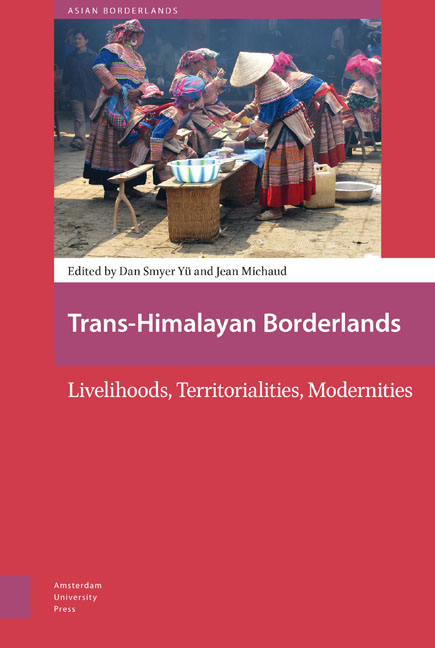Book contents
- Frontmatter
- Contents
- Acknowledgements
- Introduction: Trans-Himalayas as Multistate Margins
- I Territory, Worldviews, and Power Through Time
- 1 Adjusting Livelihood Structure in the Southeast Asian Massif
- 2 The Properties of Territory in Nepal’s State of Transformation
- 3 Trans-Himalayan Buddhist Secularities: Sino-Indian Geopolitics of Territoriality in Indo-Tibetan Interface
- 4 Buddhist Books on Trans-Himalayan Pathways: Materials and Technologies Connecting People and Ecological Environments in a Transnational Landscape
- 5 Seeking China's Back Door: On English Handkerchiefs and Global Local Markets in the Early Nineteenth Century
- II Livelihood Reconstructions, Flows, and Trans-Himalayan Modernities
- 6 Contested Modernities: Place, Subjectivity, and Himalayan Dam Infrastructures
- 7 Plurality and Plasticity of Everyday Humanitarianism in the Karen Conflict
- 8 Being Modern: Livelihood Reconstruction among Land-lost Peasants in Chenggong (Kunming)
- 9 Tibetan Wine Production, Taste of Place, and Regional Niche Identities in Shangri-La, China
- 10 Tea and Merit: Landscape Making in the Ritual Lives of the De’ang People in Western Yunnan
- 11 In-between Poppy and Rubber Fields: Experimenting a Transborder Livelihood among the Akha in the Northwestern Frontier of Laos
- 12 A Fortuitous Frontier Opportunity: Cardamom Livelihoods in the Sino-Vietnamese Borderlands
- Conclusion: Frictions in Trans-Himalayan Studies
- Index
12 - A Fortuitous Frontier Opportunity: Cardamom Livelihoods in the Sino-Vietnamese Borderlands
Published online by Cambridge University Press: 12 December 2020
- Frontmatter
- Contents
- Acknowledgements
- Introduction: Trans-Himalayas as Multistate Margins
- I Territory, Worldviews, and Power Through Time
- 1 Adjusting Livelihood Structure in the Southeast Asian Massif
- 2 The Properties of Territory in Nepal’s State of Transformation
- 3 Trans-Himalayan Buddhist Secularities: Sino-Indian Geopolitics of Territoriality in Indo-Tibetan Interface
- 4 Buddhist Books on Trans-Himalayan Pathways: Materials and Technologies Connecting People and Ecological Environments in a Transnational Landscape
- 5 Seeking China's Back Door: On English Handkerchiefs and Global Local Markets in the Early Nineteenth Century
- II Livelihood Reconstructions, Flows, and Trans-Himalayan Modernities
- 6 Contested Modernities: Place, Subjectivity, and Himalayan Dam Infrastructures
- 7 Plurality and Plasticity of Everyday Humanitarianism in the Karen Conflict
- 8 Being Modern: Livelihood Reconstruction among Land-lost Peasants in Chenggong (Kunming)
- 9 Tibetan Wine Production, Taste of Place, and Regional Niche Identities in Shangri-La, China
- 10 Tea and Merit: Landscape Making in the Ritual Lives of the De’ang People in Western Yunnan
- 11 In-between Poppy and Rubber Fields: Experimenting a Transborder Livelihood among the Akha in the Northwestern Frontier of Laos
- 12 A Fortuitous Frontier Opportunity: Cardamom Livelihoods in the Sino-Vietnamese Borderlands
- Conclusion: Frictions in Trans-Himalayan Studies
- Index
Summary
Abstract
Rural livelihoods in the Sino-Vietnamese borderlands are in a state of flux. While some upland societies have been cautious about altering long-standing practices, others have embraced new prospects offered by agrarian transformations, far-reaching commodity markets, and commercial intensification. The dilemmas created by such opportunities are especially palpable in the case of one upland nontimber forest product, black cardamom, now increasingly commoditized across these borderlands. Demand for this high-value spice has risen steadily over the last two decades, and many ethnic minority farmers have seized the opportunity to cultivate cardamom under the forest canopy. Yet this trade includes complex webs of social relationships, uneven power structures, and very different economic returns for different actors competing to access key resources.
Keywords: Rural livelihoods, Sino-Vietnamese borderlands, Hmong, nontimber forest products, commodity chains
Introduction
On both sides of the Sino-Vietnamese borderline, across a frontier region that incorporates upland northern Vietnam and southeast Yunnan, rural livelihoods are being tested, negotiated, and transformed in response to an inflow of industrialized agricultural methods and far-reaching commodity markets. Commercial intensification, resource- extraction projects, market liberalization, and new infrastructure and communications technologies are all playing key roles in diversifying the life projects of local, rural inhabitants. Since the start of reforms in the late 1970s in China and mid-1980s in Vietnam loosened the grip of these communist states over their flagging economies, this frontier region has witnessed collective property regimes being reorganized into private land-use rights, the strong promotion of cash cropping, and shifting cultivators being encouraged to become permanent, settled farmers.
As an important conceptual marker, the term ‘frontier’ often denotes landscapes used for extracting natural resources, politically marginalized locales, or sites where minority ‘other’ populations dwell, in addition to other interpretations. The term therefore seems apt to describe these borderlands, although it is important to note that ‘borderlands’ and ‘frontiers’ are not always one and the same. Historically, the frontier concept had two divergent definitions. Frederick Jackson Turner, writing in 1894 about the colonial conquest of the United States of America, (in)famously defined the frontier as ‘the meeting point between savagery and civilization’ (1894: 200). He drew a distinction between US and European versions of the frontier, suggesting that in contrast to the US version, the European frontier consists of ‘a fortified boundary line running through dense populations.’
- Type
- Chapter
- Information
- Trans-Himalayan BorderlandsLivelihoods, Territorialities, Modernities, pp. 263 - 284Publisher: Amsterdam University PressPrint publication year: 2017



